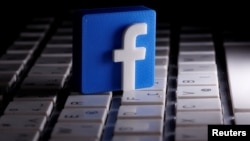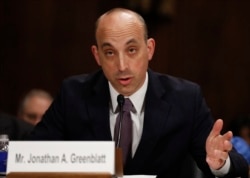Facebook has removed dozens of official Donald Trump advertisements, saying they violated the social media platform’s policy against organized hate.
“We don’t allow symbols that represent hateful organizations or hateful ideologies unless they’re put up with context or condemnation,” Facebook’s head of security policy, Nathaniel Gleicher, told the House Intelligence Committee on Thursday. “That’s what we saw in this case with this ad, and anywhere that that symbol is used we would take the same actions.”
A controversy erupted on Twitter earlier in the day about the "stop antifa" ads, created by the U.S. president’s re-election campaign. A liberal Jewish advocacy group was among those noting that the advertisements’ red inverted triangle was a marking once used by the Nazis to designate political prisoners in concentration camps.
"We have nothing to do with that,” White House spokesman Judd Deere told VOA, referring the matter to the Trump political campaign.
The Facebook ads, which were seen by more than 1 million users, appeared on the president’s official account, Vice President Mike Pence’s official account and the official Trump campaign account.
“Dangerous MOBS of far-left groups are running through our streets and causing absolute mayhem,” the ads said with the red triangle below the text.
The president has called for antifa to be designated a domestic terrorist organization, and he has claimed it was involved in violent acts during recent civil unrest across the United States that was sparked by the death of a black man in police custody on a Minneapolis street.
Trump’s campaign contends the use of the symbol in its ads was to point out the dangers of the anti-fascist movement, not as a direct reference to Nazi concentration camp prisoners.
“The inverted red triangle is a symbol used by antifa, so it was included in an ad about antifa. We would note that Facebook still has an inverted red triangle emoji in use, which looks exactly the same, so it’s curious that they would target only this ad,” responded the Trump campaign’s director of communication, Tim Murtaugh. “The image is also not included in the Anti-Defamation League’s database of symbols of hate. But it is ironic that it took a Trump ad to force the media to implicitly concede that antifa is a hate group.”
The Anti-Defamation League (ADL), a 107-year-old Jewish organization that fights discrimination and bias, points out that its database is not one of historical Nazi symbols, but rather lists symbols commonly used by modern extremists and white supremacists in the United States.
The organization also said that while some antifa activists have used the red triangle, it is not a particularly common symbol linked to the group and its use is similar to the use of the pink triangle by some LGBTQ+ groups.
"Usage of a concentration camp symbol by the heirs of persecuted categories, such as anti-fascists and those in the LGBTQ+ community, is however very different from someone using a Nazi concentration camp image to label one's enemies,” the organization said in a statement.
ADL Chief Executive Officer Jonathan Greenblatt told VOA that whether or not the Trump campaign was aware of the history or meaning of the symbol, to use it to attack the president’s opponents “is offensive and deeply troubling. It is not difficult for one to criticize their political opponent without using Nazi-era imagery. We implore the Trump campaign to take greater caution and familiarize themselves with the historical context before doing so. Ignorance is not an excuse for appropriating hateful symbols.”
The Trump campaign emphasized that the symbol is in wide use as a social media emoji to denote a navigation aid and as a downward movement for stocks.
Other Trump campaign ads with identical language featuring different images, including stop signs and exclamation points, were still visible in the Facebook ad library after the red triangle ads were deactivated.
The red inverted triangle, according to historians, first came into use by the Nazis in the 1930s to identify Communists. It was also used to denote Social Democrats, liberals, Freemasons and other members of opposition parties.
A red inverted triangle superimposed on a yellow triangle was a badge that Jewish political prisoners were forced to wear by the Nazis.
A six-pointed Star of David along $100 bills with a graphic showing Democratic Party presidential candidate Hillary Clinton was tweeted and then deleted by Trump during the 2016 campaign against the former secretary of state. Republican candidate Trump stated that the insignia was not anti-Semitic because the star represented a sheriff’s badge.
VOA correspondent Patsy Widakuswara at the White House and Jeff Seldin, national security correspondent, contributed to this report.






























